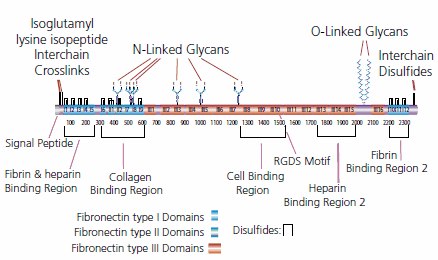Fibronectin
George Sitterley
MilliporeSigma, St. Louis
Fibronectin (FN) is a multifunctional, extracellular matrix glycoprotein composed of two nearly identical disulfide bound polypeptides of molecular weight 220 kDa. Cellular fibronectin is structurally and antigenically similar to cold insoluble globulin from plasma, therefore polyclonal antibodies to either form usually crossreact. Careful analysis of the fibronectin molecule indicate that it contains several functionally and structurally distinct domains which may bind to cell surfaces, collagen, fibrinogen or fibrin, complement, glycosaminoglycans, proteoglycans and heparin. Numerous studies have shown that fibronectin may enhance cell adhesion and spreading and affect the routes of cell migration both in vivo and in culture. Moreover, it has been shown that upon malignant transformation many cells lose most of their surface bound fibronectin. Fibronectin has been shown to also play a role in cellular morphology, cytoskeletal organization, phagocytosis, hemostasis, embryonic differentiation and wound repair. Fibronectin is produced by a wide variety of epithelial and mesenchymal cells in vitro including: fibroblasts, chondrocytes, myoblasts, Schwann cells, macrophages, hepatocytes and intestinal epithelial cells. Cellular fibronectin is present in many tissues including spleen, lymph node, tonsil, blood vessel walls, liver, kidney, muscle, skin, brain and peripheral nerves. It is found in basement membranes and in loose connective tissue stroma. It is also present in platelet α-granules and is expressed on the platelet surface after activation.

Fibronectin (FN) is a multifunctional, extracellular matrix glycoprotein composed of two nearly identical disulfide bound polypeptides of molecular weight 220 kDa.
Fibronectins
Materials
To continue reading please sign in or create an account.
Don't Have An Account?